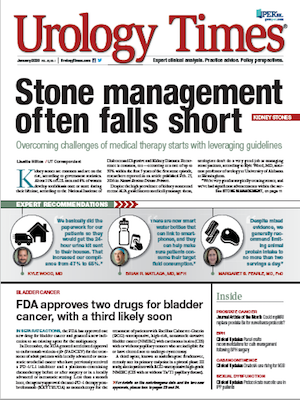Publication
Article
Urology Times Journal
Pain-focused stone patients less likely to reach treatment goals
Author(s):
Patients with kidney stones who rank their pain at the maximum level on a 100-point scale or whose number-one goal for treatment is to relieve pain are less likely to reach their treatment goals than other patients undergoing kidney stone treatment, a recent study found.
Prostock-studio - stock.adobe.com

Chicago-Patients with kidney stones who rank their pain at the maximum level on a 100-point scale or whose number-one goal for treatment is to relieve pain are less likely to reach their treatment goals than other patients undergoing kidney stone treatment, a recent study found.
Nicholas Koch, a medical student at the University of North Carolina School of Medicine in Chapel Hill, sought to determine how patients with symptomatic kidney stones evaluate their treatment outcomes after kidney stone surgery. Typically, these outcomes are assessed by physicians and are based on whether the patient has gained complete relief of their kidney stone burden. However, this approach doesn’t consider the patient’s expectations for symptom relief and what the patient would consider to be a successful outcome.
Also see: Protocol cuts opioid prescribing in stone patients
Under the direction of Davis Viprakasit, MD, Koch worked with the UNC department of biostatistics and UNC urologists to modify the Patient-Centered Outcomes Questionnaire to dig deeper. The goal: to explore the differences in patient-defined outcomes between kidney stone patients who ranked pain control as extremely important and those who did not.
Modified questionnaire used for study
Fifty-nine symptomatic patients undergoing ureteroscopic or percutaneous stone surgery participated and completed the modified, stone-specific questionnaire before surgery and during their routine postoperative follow-up. The survey measured patients’ expected, desired, and success levels of pain symptoms following surgery. Koch then compared responses from patients who were highly pain focused and those who were less so.
Sixty-eight percent of the respondents were women. The average age of respondents was 54.9 years. Among those surveyed, 69% had a history of stone disease. The percentage of pain-focused patients who had previously dealt with kidney stones was significantly higher than non-pain-focused patients with a history of disease.
Next:"Pain-focused patients were uniformly less likely to report achieving desired outcomes after surgery"The results were striking: “Pain-focused patients were uniformly less likely to report achieving desired outcomes after surgery,” Koch said during a presentation at the 2019 AUA annual meeting in Chicago.
Pain-focused patients required a larger reduction in symptoms to meet their criteria for desired, expected, and success-level outcomes, the authors found. Although non-pain-focused patients also desired significant reductions in pain, overall, these patients expected and would accept lower levels of improvement in symptoms to consider treatment successful.
Read: Can I charge for different stone procedures in the same kidney?
Overall, all patients demonstrated significant improvement in pain symptoms following surgery. However, patients who rated pain as their primary criteria for success were significantly less likely to reach their expected outcome level for pain (p<.05) and were less likely to meet their defined criteria for success.
“These patients may require pain therapies to develop more realistic treatment goals,” Koch said.
We want to hear from you! Send us your comments at urology_times@mmhgroup.com































